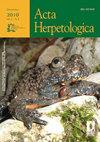Sunny-side up: ontogenetic variation in egg mass temperatures of the wood frog Rana sylvatica
IF 0.9
4区 生物学
Q4 ZOOLOGY
引用次数: 0
Abstract
The efficacy of most biological processes is temperature dependent and, within physiological limits, on average, warmer is better. This axiom of biology has led to a wide range of adaptations for dealing with temperatures that are outside of an organism’s preferred temperature. Many pond-breeding amphibians lay their eggs during early spring, when water temperatures are near freezing. Communal nest-site selection has been proposed as a mechanism to increase developmental temperatures, and temperatures near the center of egg-mass aggregations are elevated relative to egg-masses on the aggregation’s periphery. It is unclear whether this spatial variation in temperature is due to concentration of metabolic heat, absorption of solar radiation, or both. Here, we explore finer scale spatial variation within egg masses of the wood frog Rana sylvatica, one of the earliest amphibians to breed during the North American spring. We compared peripheral and core temperatures of egg masses that were exposed either to 1) ambient sunlight from above, or 2) sunlight reflected by a mirror from below. We found that differences between core and peripheral temperatures were higher in the control than in the mirror treatment, but core and peripheral temperatures were statistically indistinguishable in both cases. Moreover, the difference in peripheral and internal temperatures increased significantly over the course of development. However, these trends were only significant in ambient sunlight and actually decreased in the mirror group. Our results suggest that the benefits of communal nesting are also experienced by individual egg masses, albeit to a lesser extent. In addition, the lack of effect in shaded egg masses suggests that the thermal advantage is tied to sun exposure and not due to concentration of metabolic heat.阳面朝上:林蛙(Rana sylvatica)卵团温度的个体发生变异
大多数生物过程的功效取决于温度,在生理限度内,平均而言,温度越高越好。这一生物学公理导致了各种适应,以应对超出有机体偏好温度的温度。许多在池塘里繁殖的两栖动物在早春产卵,那时水温接近冰点。公共巢址选择被认为是提高发育温度的一种机制,靠近卵团聚集中心的温度相对于聚集外围的卵团要高。目前尚不清楚这种温度的空间变化是由于代谢热的集中,太阳辐射的吸收,还是两者兼而有之。在这里,我们探索了林蛙(Rana sylvatica)卵团的精细尺度空间变化,林蛙是北美春季最早繁殖的两栖动物之一。我们比较了蛋团的外围和核心温度,这些蛋团分别暴露在1)上方的环境阳光和2)下方镜子反射的阳光下。我们发现,对照组的核心和外周温度的差异高于镜像处理,但在两种情况下核心和外周温度在统计上无法区分。此外,外围和内部温度的差异在发育过程中显著增加。然而,这些趋势只在周围的阳光下显著,而在镜子组中实际上有所下降。我们的研究结果表明,集体筑巢的好处也可以通过单个卵群体验到,尽管程度较低。此外,在阴暗的卵群中缺乏效果表明,热优势与阳光照射有关,而不是由于代谢热的集中。
本文章由计算机程序翻译,如有差异,请以英文原文为准。
求助全文
约1分钟内获得全文
求助全文
来源期刊

Acta Herpetologica
ZOOLOGY-
CiteScore
1.20
自引率
12.50%
发文量
10
审稿时长
6 months
期刊介绍:
Acta Herpetologica, a journal open to academics all over the world, offers itself as a new site for the presentation and discussion of the most recent results in the field of research on Amphibians and Reptiles, both living and extinct. The official journal of the Societas Herpetologica Italica (S.H.I.), Acta Herpetologica publishes original works – extended articles, short notes and book reviews – mostly in English, dealing with the biology and diversity of Amphibians and Reptiles.
 求助内容:
求助内容: 应助结果提醒方式:
应助结果提醒方式:


